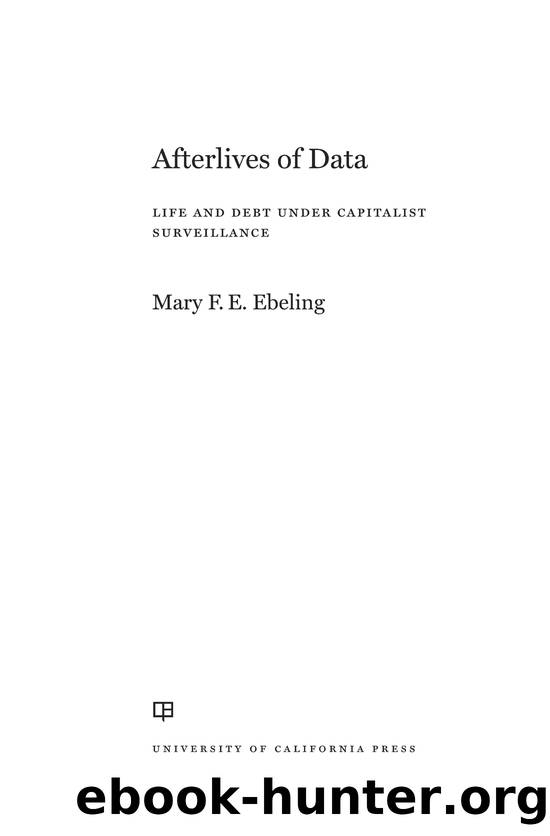Afterlives of Data by Mary F.E. Ebeling

Author:Mary F.E. Ebeling
Language: eng
Format: epub
ISBN: 9780520307728
Publisher: University of California Press
ALL DATA ARE CREDIT (AND HEALTH) DATA
The three largest credit bureaus make inferences about a personâs health based on data contained within the bureausâ own financial information products. Customer car ownership, fast food purchases, medical debt, financing, and credit use for healthcare are types of information embedded within these data products (Wei et al. 2016). Analysts make inferences about a personâs class or access to healthy food based on consumer and credit data, and these insights are sold to healthcare providers to make better sense of a patientâs social context and what it might mean for their health. But this also means that a patient is no longer solely under the medical industryâs gaze, but is made legible and subject to marketing and the debt societyâs surveillance (Lazzarato 2015; Waldby 1998). Without a credit history score, like the FICO score, or with a âbadâ score, patients face further marginalization in healthcare settings because of their debt, purchasing behaviors, or even their financial and real assets.12 For those whom the healthcare or banking industries already marginalize due to their immigration status, gender, race, or class, this profiling can have dire consequences for their health and negatively impact virtually all aspects of their lives.
In the hands of commercial interests, all data can be used to make inferences about health, even in the context of a covered entity that would be considered private. Patient health information produced in a doctorâs office and protected under HIPAA can be exactly the same data collected from our smartphones but not protected under HIPAA. The privacy of data is thus context dependent (Nissenbaum 2011; Scholz 2016). Information that may be regulated for privacy in one setting is fair game in another (Schwartz 2009). Previously, with paper-based healthcare and records systems, these contexts were easier to control, ensuring that patient information produced in a doctorâs office would not be (easily) reidentifiable in other, nonmedical contexts. But as data now swims in a vast digital ocean, these contextual boundaries have virtually disappeared.
The consumer profiles that credit bureaus hold will undoubtedly include data about an individualâs health, types of medical services obtained, and the amount of medical debt that is in collections after 180 days of nonpayment. For patients dealing with expensive medical diagnoses, such as cancer, these debts can reach the hundreds of thousands of dollars and will be reflected in the score, resulting in what is called medical financial toxicity. Since this information is about a patientâs medical debt burden, it is still considered to be traditional financial information. But by utilizing âfringe alternative data,â from consumer, social media, and web tracking sources, credit bureaus score customers through the application of behavioral predictive analytics, and they can make inferences about a personâs health and medical information, either based on HIPAA-regulated information or through consumer data gleaned outside of HIPAA protections (Robinson + Yu 2014).
Since credit bureaus hold massive amounts of personal identifying and nonfinancial data on most Americans, virtually all the identifiers that constitute PHI overlap with data the credit reporting companies hold.
Download
This site does not store any files on its server. We only index and link to content provided by other sites. Please contact the content providers to delete copyright contents if any and email us, we'll remove relevant links or contents immediately.
When Breath Becomes Air by Paul Kalanithi(7285)
Why We Sleep: Unlocking the Power of Sleep and Dreams by Matthew Walker(5674)
Paper Towns by Green John(4184)
The Immortal Life of Henrietta Lacks by Rebecca Skloot(3838)
The Sports Rules Book by Human Kinetics(3605)
Dynamic Alignment Through Imagery by Eric Franklin(3508)
ACSM's Complete Guide to Fitness & Health by ACSM(3478)
Kaplan MCAT Organic Chemistry Review: Created for MCAT 2015 (Kaplan Test Prep) by Kaplan(3432)
Introduction to Kinesiology by Shirl J. Hoffman(3311)
Livewired by David Eagleman(3146)
The River of Consciousness by Oliver Sacks(3004)
Alchemy and Alchemists by C. J. S. Thompson(2920)
The Death of the Heart by Elizabeth Bowen(2916)
Descartes' Error by Antonio Damasio(2753)
Bad Pharma by Ben Goldacre(2738)
The Gene: An Intimate History by Siddhartha Mukherjee(2506)
Kaplan MCAT Behavioral Sciences Review: Created for MCAT 2015 (Kaplan Test Prep) by Kaplan(2496)
The Fate of Rome: Climate, Disease, and the End of an Empire (The Princeton History of the Ancient World) by Kyle Harper(2448)
The Emperor of All Maladies: A Biography of Cancer by Siddhartha Mukherjee(2443)
